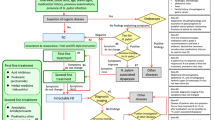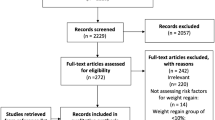Abstract
Background
Esophageal shortening is a complication of advanced gastroesophageal reflux disease (GERD). For patients with short esophagus, Collis gastroplasty combined with fundoplication provides excellent symptomatic relief from GERD disease. The literature lacks studies comparing satisfaction and reflux symptoms between patients who underwent Nissen fundoplication with Collis gastroplasty and those who had primary fundoplication alone. This study aimed to assess long-term satisfaction and GERD-related quality of life after laparoscopic Collis–Nissen fundoplication, and to compare them with those for Nissen fundoplication alone.
Methods
A nested case–control study was conducted. In this study, 14 cases of laparoscopic Collis–Nissen fundoplications were matched for age, gender, and length of the follow-up period to a cohort of 120 control subjects who underwent laparoscopic Nissen fundoplication. All the patients were mailed a follow-up survey which included a Short Form-12 (SF-12) health status (quality-of-life) questionnaire (a validated quality-of-life instrument), a Quality of Life in Reflux and Dyspepsia (QOLRAD) questionnaire (a GERD-specific quality-of-life instrument), and queries regarding long-term satisfaction and medication use.
Results
Both groups showed a significant postoperative increase in QOLRAD mean scores (p = 0.01). However, the difference in the delta (postoperative–preoperative) score between the two groups was not significant (Fig. 1). There were no differences in mental (MCS) or physical (PCS) SF-12 scores between the two groups. The rate of satisfaction with the surgery was similar in the Nissen–Collis fundoplication (87.5%) and Nissen fundoplication (87%) groups.

Quality of Life in Reflux and Dyspepsia (QOLRAD) score in the two groups. (* p = 0.01 vs preoperative value)
Conclusions
Collis gastroplasty combined with Nissen fundoplication is an effective procedure for patients with a shortened esophagus diagnosed intraoperatively during antireflux surgery. Patient satisfaction, postoperative quality of life, and QOLRAD score improvement after this procedure are comparable with those observed in patients treated with Nissen fundoplication alone.

Similar content being viewed by others
References
Kahrilas PJ (1996) Gastroesophageal reflux disease. JAMA 276: 983–988
Lafullarde T, Watson DI, Jamieson GG, Myers JC, Game PA, Devitt PG (2001) Laparoscopic Nissen fundoplication: five-year results and beyond. Arch Surg 136: 180–184
Pearson FG, Cooper JD, Patterson GA, Ramirez J, Todd TR (1987) Gastroplasty and fundoplication for complex reflux problems: long-term results. Ann Surg 206: 473–481
Peters JH, DeMeester TR (1995) The lessons of failed antireflux repairs: minimally invasive surgery of the foregut. St Louis, MO pp 183–190
Urbach DR, et al. (2001) Preoperative determinants of an esophageal-lengthening procedure in laparoscopic antireflux surgery. Surg Endosc 15: 1408–1412
Pearson F (1995) Peptic esophagitis, stricture, and short esophagus: esophageal surgery. Churchill Livingstone, New York
Pearson FG (1997) Hiatus hernia and gastroesophageal reflux: indications for surgery and selection of operation. Semin Thorac Cardiovasc Surg 9: 163–168
Swanstrom LL, Marcus DR, Galloway GQ (1996) Laparoscopic Collis gastroplasty is the treatment of choice for the shortened esophagus. Am J Surg 171: 477–481
del Pino Porres FJ, Sancho Fornos S, Rodriguez Magallon C (1996) Reoperation after failure of gastroesophageal reflux surgery. Rev Esp Enferm Dig 88: 173–178
Cooper JD, et al. (1977) Intraoperative and postoperative esophageal manometric findings with Collis gastroplasty and Belsey hiatal hernia repair for gastroesophageal reflux. J Thorac Cardiovasc Surg 74: 744–751
Jobe BA, Horvath KD, Swanstrom LL (1998) Postoperative function following laparoscopic collis gastroplasty for shortened esophagus. Arch Surg 133: 867–874
O’Rourke RW, et al. (2003) Extended transmediastinal dissection: an alternative to gastroplasty for short esophagus. Arch Surg 138: 735–740
Collis JL (1957) An operation for hiatus hernia with short esophagus. J Thorac Surg 34: 768–773, discussion 774–778
Henderson RD, Marryatt GV (1985) Transabdominal total fundoplication gastroplasty to control reflux: a preliminary report. Can J Surg 28: 127–129
Steichen FM (1986) Abdominal approach to the Collis gastroplasty and Nissen fundoplication. Surg Gynecol Obstet 162: 272–274
Johnson AB, Oddsdottir M, Hunter JG (1998) Laparoscopic Collis gastroplasty and Nissen fundoplication: a new technique for the management of esophageal foreshortening. Surg Endosc 12: 1055–1060
Terry ML, Vernon A, Hunter JG (2004) Stapled-wedge Collis gastroplasty for the shortened esophagus. Am J Surg 188: 195–199
Streets CG, et al. (2002) Excellent quality of life after Nissen fundoplication depends on successful elimination of reflux symptoms and not the invasiveness of the surgical approach. Ann Thorac Surg 74: 1019–1024, discussion 1024–1025
Kamolz T, Granderath FA, Pointner R (2002) Quality of life 2 years after laparoscopic total fundoplication. Surg Laparosc Endosc Percutan Tech 12: 305, author reply 306
Barrat C, et al. (2001) Quality of life 2 years after laparoscopic total fundoplication: a prospective study. Surg Laparosc Endosc Percutan Tech 11: 347–350
McHorney CA, Ware JE Jr, Raczek AE (1993) The MOS 36-Item Short-Form Health Survey (SF-36): II. Psychometric and clinical tests of validity in measuring physical and mental health constructs. Med Care 31: 247–263
Ware JE, Snow KK, Kosinski M, Gandek B (1993) SF-36 health survey: manual and interpretation guide. The Health Institute, New England Medical Center, Boston, MA
Wiklund IK, et al. (1998) Quality of Life in Reflux and Dyspepsia patients: psychometric documentation of a new disease-specific questionnaire (QOLRAD). Eur J Surg Suppl 583: 41–49
Mahon D, et al. (2005) Randomized clinical trial of laparoscopic Nissen fundoplication compared with proton pump inhibitors for treatment of chronic gastro-oesophageal reflux. Br J Surg 92: 695–699
Richards WO, et al. (2003) Paradigm shift in the management of gastroesophageal reflux disease. Ann Surg 237: 638–647, discussion 648–649
Hunter JG, et al. (1996) A physiologic approach to laparoscopic fundoplication for gastroesophageal reflux disease. Ann Surg 223: 673–685, discussion 685–687
Hunter JG, et al. (1999) Laparoscopic fundoplication failures: patterns of failure and response to fundoplication revision. Ann Surg 230: 595–604, discussion 604–606
Horvath KD, Swanstrom LL, Jobe BA (2000) The short esophagus: pathophysiology, incidence, presentation, and treatment in the era of laparoscopic antireflux surgery. Ann Surg 232: 630–640
Watson DI, et al. (1995) Paraoesophageal hiatus hernia: an important complication of laparoscopic Nissen fundoplication. Br J Surg 82: 521–523
Lin E, et al. (2004) Disparity between symptomatic and physiologic outcomes following esophageal lengthening procedures for antireflux surgery. J Gastrointest Surg 8: 31–39, discussion 38–39
Chen LQ, et al. (2005) Antireflux surgery for Barrett’s esophagus: comparative results of the Nissen and Collis-Nissen operations. Dis Esophagus 18: 320–328
Author information
Authors and Affiliations
Corresponding author
Rights and permissions
About this article
Cite this article
Youssef, Y.K., Shekar, N., Lutfi, R. et al. Long-term evaluation of patient satisfaction and reflux symptoms after laparoscopic fundoplication with Collis gastroplasty. Surg Endosc 20, 1702–1705 (2006). https://doi.org/10.1007/s00464-006-0048-x
Received:
Accepted:
Published:
Issue Date:
DOI: https://doi.org/10.1007/s00464-006-0048-x




